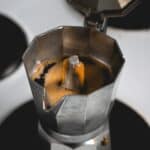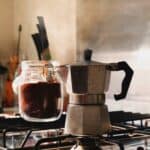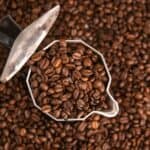Moka Pot Yield Explained

Brewing coffee with a Moka Pot is a delightful experience that combines art and science. In this article, we will explore the perfect ratio for making 3 cups of coffee using a Moka Pot. Understanding the nuances of ratios and mastering the brewing process will elevate your coffee game to new heights.
Key Takeaways
- Choosing the right coffee beans is crucial for a flavorful brew.
- Grinding the coffee to the perfect consistency enhances extraction.
- Mastering the brewing process ensures a rich and aromatic cup of coffee.
- Balancing strength and flavor in your coffee ratio is key to a satisfying brew.
- Preheating the water in your Moka Pot can improve the extraction process.
Understanding the Importance of Ratios
The Science Behind Coffee Extraction
Coffee extraction is about finding the perfect balance between water temperature, grind size, and contact time. The goal is to extract the desirable flavors while leaving behind the bitter compounds.
Coffee extraction is not just about mixing water with ground coffee. It’s a complex chemical reaction where hot water acts as a solvent, pulling out the flavors, oils, and caffeine from the coffee grounds. The key variables that I consider in this process are:
- Water temperature
- Grind size
- Contact time
- Coffee-to-water ratio
The ideal extraction yields a cup that’s rich and full-bodied, with a complexity of flavors that’s both satisfying and invigorating.
Understanding these variables allows me to manipulate the extraction to suit my taste. For instance, a finer grind increases the surface area, leading to a quicker extraction, which is perfect for a Moka pot. On the other hand, too fine a grind or too long a contact time can lead to over-extraction, resulting in a bitter taste.
Balancing Strength and Flavor
Balancing out coffee strength and flavor is not always easy.
Moka Pot Yield Explained in Detail
Generally speaking, Moka Pots produce pretty strong coffee.
This is because they extract coffee oils and flavors from finely ground coffee beans using intense heat and pressure.
Therefore, Moka Pot coffee is generally enjoyed as a substitute to espresso (more accurately a lungo), so diluted down with hot water and milk to form an americano.
With that being said, according to Batch Brew’s article How to Use a Moka Pot Stovetop Coffee Maker, a typical 3 pot Moka pot will produce around 180g/6.5oz of coffee.
A 6 Cup Moka Pot will make approx. 270g/9.5oz coffee, and a large 9 Cup Moka Pot produces around 500/17.5oz grams brewed coffee
When you compare this to a typical 18g in 36g out 1:2 espresso ratio, a Moka Pot seems to produce around double the yield, but the coffee itself will have a lower TDS and therefore be less intense.
Overall, I would say that a strong Moka Pot brew will work just as well when diluted down with hot water and milk, as it does as a standalone intense shot of coffee.
Therefore, I would argue that a 3 cup Moka Pot will comfortably serve 3 people, assuming they will be drinking the coffee either on its own as a shot, or further diluting it down with milk and sugar once being served.
Achieving Consistent Results
I’ve learned that consistency is key when it comes to brewing coffee with a Moka pot. By using the same coffee-to-water ratio each time, you can expect a reliable taste and strength in every cup. This doesn’t mean you can’t experiment, but having a baseline is crucial for comparison and refinement.
Once you’ve dialed in your preferred ratio, it becomes much easier to replicate your ideal cup of coffee, even when switching between different beans or Moka pots. It’s all about finding that sweet spot and maintaining it with precision and care.
Exploring Different Ratios for 3 Cups
Classic 1:3 Ratio
When I first started using my Moka Pot, I quickly learned that the classic 1:3 coffee-to-water ratio is a reliable starting point for a balanced brew. This ratio means for every gram of coffee, I use three grams of water. It’s a simple yet effective way to ensure that each cup has a harmonious blend of strength and flavor.
Essentially, you’ll want to fill your Moka Pot’s filter basket up to the top with ground coffee, and then add approximately three times the amount of water to the brewing chamber below.
An easy way to measure out how much coffee you’ll need (if you’re grinding your own beans), is to simply fill your filter basket up with whole beans, then grind this amount to a medium/fine consistency.
Customizing Your Brew
After exploring the classic and slightly more diluted ratios, I’ve come to appreciate the art of customizing my brew. Finding the perfect balance for your taste buds is a journey worth taking. It’s not just about following a recipe; it’s about understanding how each variable affects the final cup. To start, consider the bean’s origin, roast, and your personal preference for strength and flavor.
- Start with the classic 1:3 ratio as a baseline.
- Adjust the coffee amount for a stronger or milder taste.
- Experiment with the water temperature and brewing time.
Remember, the goal is to create a cup of coffee that resonates with your unique palate. Don’t be afraid to deviate from the norms and trust your senses.
The Art of Brewing Coffee with a Moka Pot

Choosing the Right Coffee Beans
Selecting high-quality beans is crucial for achieving that rich, full-bodied flavor we all crave.
Here’s a quick rundown of what I look for in coffee beans:
- Origin: Single-origin beans often offer unique flavors and aromas.
- Roast: A medium roast is versatile and brings out a balanced profile.
- Freshness: Always check the roast date; fresher is better.
Remember, the bean you choose sets the stage for your entire brewing process. It’s not just about the bean’s origin or roast; it’s about how those beans will interact with your Moka Pot to create a harmonious cup of coffee.
Grinding the Coffee to Perfection
Once I’ve selected the ideal coffee beans for my Moka pot, the next crucial step is grinding them to the perfect consistency. Achieving the right grind size is essential for the extraction process, as it influences the brewing time and, ultimately, the flavor of the coffee. For a Moka pot, the best grind is somewhere between the fine grind of espresso and the coarser grind used for drip coffee makers.
The grind should not be too fine to prevent it from passing through the filter and into your cup, nor too coarse to under-extract the coffee, leaving you with a weak brew.
Here’s a simple guide to help you find the right grind size:
- Start with a medium-fine grind.
- Adjust finer if the coffee brews too quickly and tastes weak.
- Go coarser if the coffee takes too long to brew and tastes bitter.
Remember, consistency is key. A uniform grind ensures even extraction and a balanced cup of coffee. It’s worth investing in a good quality burr grinder to get the best results. Experimenting a little will help you discover the grind that works best for your taste and your Moka pot.
Mastering the Brewing Process
Once you’ve selected your beans and ground them to the ideal coarseness, it’s time to focus on the brewing process itself. The key to a great Moka pot coffee is managing the heat. You want to find that sweet spot where the water is hot enough to extract the flavors effectively, but not so hot that it scorches the grounds or pushes the water through too quickly, resulting in a bitter taste.
Here are a few steps to ensure a smooth brewing process:
- Preheat the Moka pot on medium heat.
- Fill the lower chamber with preheated water up to the safety valve.
- Insert the filter basket, filled with your ground coffee, into the lower chamber.
- Screw the upper part of the pot on tightly to prevent steam from escaping.
- Place the pot back on the heat and wait for the coffee to start percolating into the upper chamber.
- Once the upper chamber is filled with coffee, remove the pot from the heat and serve immediately.
Remember, the brewing process is not just about following steps; it’s about engaging with your coffee. Listen to the sounds of percolation, smell the rich aromas, and watch as the dark liquid fills the chamber. This sensory experience is what makes using a Moka pot truly special.
That’s why I consider the coffee’s natural characteristics before using them in my Moka pot. For example, some beans are inherently more acidic, which can influence the overall taste, whereas others have a much smokier roast profile which brings out a completely different flavor.
A good cup of coffee should resonate with a balance of sweetness, bitterness, and acidity. It’s about finding that sweet spot where all the flavors come together to create a rich, aromatic experience.
Here’s a simple list to keep in mind when adjusting your brew:
- Start with fresh, quality beans.
- Adjust the grind size to control extraction.
- Experiment with water temperature and quantity.
- Fine-tune the ratio to suit your taste preference.
Tips for Enhancing Your Moka Pot Experience
Here are a few quick tips to enhance your Moka Pot brewing experience. For a full, in depth review of how to step up your Moka Pot game, check out my article on 17 Key Moka Pot Mistakes You Should Avoid.
Preheating the Water
I’ve found that preheating the water before adding it to the Moka pot can make a significant difference in the brewing process. By starting with hot water, the coffee grounds are less likely to be exposed to prolonged heat, which can prevent over-extraction and a burnt taste. Here’s a simple step-by-step guide to preheating your water:
- Fill a kettle with enough water for your Moka pot.
- Heat the water until it reaches a temperature just below boiling, around 195-205 degrees Fahrenheit.
- Carefully pour the hot water into the bottom chamber of your Moka pot, up to the safety valve.
- Proceed with adding your coffee grounds and assembling the Moka pot as usual.
Remember, handling hot water requires attention to avoid burns. Always use a heat-resistant glove or towel when pouring the water into your Moka pot.
Preheating the water not only speeds up the brewing process but also contributes to a more consistent extraction, which is crucial for achieving that perfect cup of coffee. It’s a simple step that echoes the precision required in other brewing methods, such as using a French press, where water temperature is key to unlocking the full potential of your coffee beans.
Maintaining Your Moka Pot
To ensure that my Moka Pot continues to produce the best coffee, I’ve learned that regular maintenance is key. After each use, I make it a habit to clean the pot with warm, soapy water. This simple step prevents coffee oils from building up and affecting the flavor of future brews.
Occasionally, I perform a deeper clean to remove any mineral deposits. I use a mixture of one part white vinegar to two parts water, filling the bottom chamber and running a brew cycle without coffee. After this, I rinse the pot thoroughly with warm water to eliminate any vinegar taste.
It’s crucial to avoid using abrasive materials or detergents that can damage the Moka Pot’s aluminum body. Instead, I opt for a soft sponge or cloth during cleaning.
Lastly, I check the rubber gasket and the filter for wear and tear. Replacing these parts when necessary can prevent leaks and ensure a perfect seal every time I brew.
Serving and Enjoying Your Coffee
After mastering the brewing process with my Moka pot, I find that the final step is just as crucial: serving and enjoying the coffee. Presentation can enhance the coffee experience significantly. I like to warm my cups before pouring the coffee to maintain its temperature. A preheated cup ensures that the first sip is as warm as the last, providing a consistent taste from start to finish.
Here’s a simple guide to serving your Moka pot coffee:
- Preheat your cups with hot water.
- Pour the coffee immediately after brewing to capture its peak flavor.
- If desired, add milk or sugar to taste, but try it black to truly appreciate the unique characteristics of the coffee.
Remember, the joy of coffee is not just in the taste but in the ritual of preparation and the moment of relaxation it brings.
Whether enjoying a quiet morning or sharing with friends, take a moment to savor the rich aroma and robust flavor that only a Moka pot can provide. The simplicity of this brewing method, coupled with the right ratio and technique, can yield a cup that rivals even the best espresso machines.
Conclusion
In conclusion, finding the perfect coffee-to-water ratio for your Moka Pot can greatly enhance your coffee brewing experience. By following the guidelines provided in this article, you can achieve a delicious and balanced cup of coffee every time. Experiment with different ratios and adjust to suit your taste preferences. Remember, the key to Moka Pot magic lies in the perfect ratio!
Moka Pot Yield Frequently Asked Questions
Medium to dark roast coffee beans are ideal for Moka Pot brewing as they provide a rich and bold flavor profile.
The coffee grounds should be similar to table salt in texture for optimal extraction and flavor.
While pre-ground coffee can be used, freshly ground coffee beans will result in a fresher and more flavorful brew.
Preheating the water helps maintain a consistent brewing temperature, leading to a more even extraction and better-tasting coffee.
Regularly disassemble the Moka Pot, clean it with warm water and mild soap, and ensure all parts are thoroughly dried to prevent buildup and maintain performance.
Yes, there are Moka Pots specifically designed for induction cooktops. Look for models with a compatible base for safe and efficient brewing.



